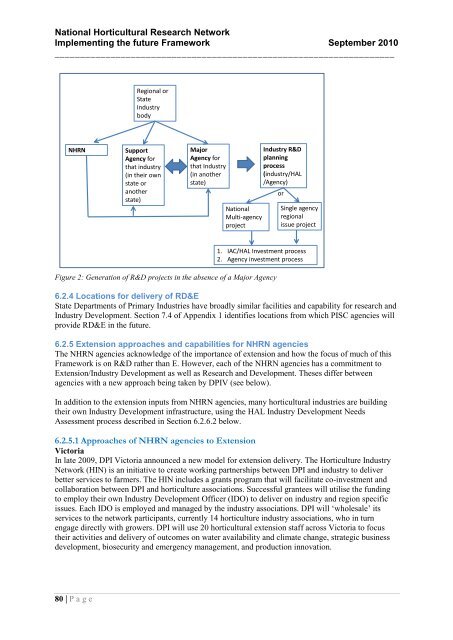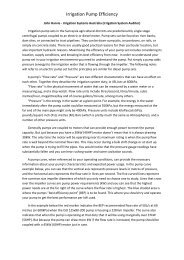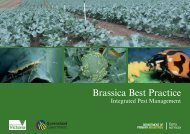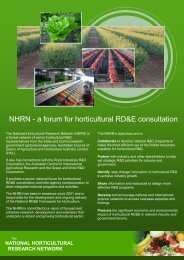National Horticultural Research Network - Horticulture Industry ...
National Horticultural Research Network - Horticulture Industry ...
National Horticultural Research Network - Horticulture Industry ...
You also want an ePaper? Increase the reach of your titles
YUMPU automatically turns print PDFs into web optimized ePapers that Google loves.
<strong>National</strong> <strong>Horticultural</strong> <strong>Research</strong> <strong>Network</strong><br />
Implementing the future Framework September 2010<br />
___________________________________________________________________<br />
Regional or<br />
State<br />
<strong>Industry</strong><br />
body<br />
NHRN<br />
Support<br />
Agency for<br />
that industry<br />
(in their own<br />
state or<br />
another<br />
state)<br />
Major<br />
Agency for<br />
that <strong>Industry</strong><br />
(in another<br />
state)<br />
<strong>National</strong><br />
Multi-agency<br />
project<br />
<strong>Industry</strong> R&D<br />
planning<br />
process<br />
(industry/HAL<br />
/Agency)<br />
or<br />
Single agency<br />
regional<br />
issue project<br />
1. IAC/HAL Investment process<br />
2. Agency investment process<br />
Figure 2: Generation of R&D projects in the absence of a Major Agency<br />
6.2.4 Locations for delivery of RD&E<br />
State Departments of Primary Industries have broadly similar facilities and capability for research and<br />
<strong>Industry</strong> Development. Section 7.4 of Appendix 1 identifies locations from which PISC agencies will<br />
provide RD&E in the future.<br />
6.2.5 Extension approaches and capabilities for NHRN agencies<br />
The NHRN agencies acknowledge of the importance of extension and how the focus of much of this<br />
Framework is on R&D rather than E. However, each of the NHRN agencies has a commitment to<br />
Extension/<strong>Industry</strong> Development as well as <strong>Research</strong> and Development. Theses differ between<br />
agencies with a new approach being taken by DPIV (see below).<br />
In addition to the extension inputs from NHRN agencies, many horticultural industries are building<br />
their own <strong>Industry</strong> Development infrastructure, using the HAL <strong>Industry</strong> Development Needs<br />
Assessment process described in Section 6.2.6.2 below.<br />
6.2.5.1 Approaches of NHRN agencies to Extension<br />
Victoria<br />
In late 2009, DPI Victoria announced a new model for extension delivery. The <strong>Horticulture</strong> <strong>Industry</strong><br />
<strong>Network</strong> (HIN) is an initiative to create working partnerships between DPI and industry to deliver<br />
better services to farmers. The HIN includes a grants program that will facilitate co-investment and<br />
collaboration between DPI and horticulture associations. Successful grantees will utilise the funding<br />
to employ their own <strong>Industry</strong> Development Officer (IDO) to deliver on industry and region specific<br />
issues. Each IDO is employed and managed by the industry associations. DPI will „wholesale‟ its<br />
services to the network participants, currently 14 horticulture industry associations, who in turn<br />
engage directly with growers. DPI will use 20 horticultural extension staff across Victoria to focus<br />
their activities and delivery of outcomes on water availability and climate change, strategic business<br />
development, biosecurity and emergency management, and production innovation.<br />
80 | P a g e






